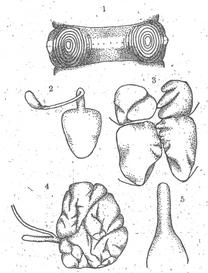トリイミミズ
Pheretima toriii Ohfuchi, 1941b: 244; 上平, 1973a: 57; Ishizuka, 1999a: 66; Tsai et al., 2007: 373.
Amynthas toriii Sims & Easton, 1972: 235.
タイプ標本
基産地:大分県川登村風連鍾乳洞(現:大分県臼杵市)
タイプ標本所在地:不明
形態
<外部形態>
全長 37-43 mm、体幅 2.3-2.7 mm、体節数 77-83。第一背孔は第 12/13 体節間溝に開始する。
体色は、背面と腹面の色の違いはない。
剛毛は第 7 体節で 41-42 本、第 20 体節で 56-58 本。
受精囊孔は 4 対で第 5/6/7/8/9 体節間溝にある。環帯は第 14-16 体節の 3 体節を占め、剛毛と体節間溝、背孔を欠く。雌性孔は第 14 体節の腹面中央に開口する。雄性孔は第 18 体節の体側にあり、楕円形の突起状で、6-8 個の円盤として突出する。雄性孔間剛毛は 7-8 本。性徴は、受精囊孔域にも雄性孔域にも全くない。
<内部形態>
隔膜は第 6/7/8 体節間では薄く、第 8/9 体節間では厚く、第 9/10 体節間では欠き、第 10/11/12/13/14/15 体節間では厚い。第 11/12/13 体節間ではとても厚い。
腸管は第 14 体節から始まる。腸盲嚢は単純状型で、第 27 体節に開口し、第 22 体節まで達する。腸盲嚢には鋸歯状の切れ込みは全くない。
受精囊は第 6-9 体節にある。受精囊の主嚢はサクランボ型もしくはさじ型で、やや平たく、長さ 1.2 mm、幅 1 mm、導管は長さ 0.5 mm。受精囊の副嚢は湾曲せずにまっすぐで、先端は膨らみ、長い導管を形成し、全長 1.6 mm。貯精嚢は腹面中央でつながり、第 10 体節の方が大きい。精巣は第 10-11 体節にある。卵巣は 1 対で小さく、第 12/13 体節間隔膜の裏側に接する。摂護腺はよく発達し、長さ 2.3 mm、幅 1.4 mm で 3 小葉に分かれ、第 16-20 体節の 5 体節分を占める。摂護腺の導管は細く、湾曲していない。

Pheretima toriii (=Amynthas toriii) の形態 (原記載図) (Ohfuchi, 1941b p. 246, fig. 2 より)
分布
大分県臼杵市の風連鍾乳洞に分布する。Ohfuchi (1941b) の新種記載以降、全く記録されていない。
生息環境
風連鍾乳洞は、1.5 x 0.6 m の楕円形の入り口からすぐに 10 m のほぼ垂直の縦穴があり、その後、水平に 80 m ほど続く。この洞窟に堆積する湿った土壌に生息する (Ohfuchi, 1941b)。
備考
Easton (1981) によりヘンイセイミミズのシノニムとされ、Blakemore (2003, 2008d, 2012b) はこの見解に従っている。
小型であること(トリイミミズは体長 37-43 mm、ヘンイセイミミズは45-107 mm)、剛毛数が異なること(トリイミミズは第 8 体節に 43−45 本、第 20 体節に 56−58 本、ヘンイセイミミズは第 8 体節に 26−46 本、第 20 体節に 39−54 本)、雄性孔の周囲の皮膚の隆起数が異なり性徴を欠くこと(トリイミミズは 6〜8 層、ヘンイセイミミズは 1〜数層)、摂護腺の導管の形態が異なることから(トリイミミズは細長くまっすぐ、ヘンイセイミミズは U 字型または C 字型)、Tsai et al. (2007) により再び独立種とされた。新たな標本を採集して、分子系統学的検討を含む今後の研究が必要である。
シノニムリスト
Pheretima toriii Ohfuchi, 1941b: 244. [形態記載]
Amynthas toriii Sims & Easton, 1972: 235. [記述のみ] (Sep ?, 1972)
Pheretima toriii 上平, 1973a: 57 トリイミミズ. [同定形質のみ] (?, 1973)
Pheretima toriii Ishizuka, 1999a: 66. [記述のみ]
Pheretima toriii Tsai et al., 2007: 373. [特徴指摘]
引用文献
Blakemore, R.J., 2003. Japanese earthworms (Annelida: Oligochaeta): A review and checklist of species. Organisms Diversity and Evolution 11: 1-43.
Blakemore, R.J., 2008d. A review of Japanese earthworms after Blakemore (2003). In: Ito MT, Kaneko N, (eds.), A Series of Searchable Texts on Earthworm Biodiversity, Ecology and Systematics from Various Regions of the World, 2nd Edition (2006) and Supplemental. COE soil Ecology Research Group, Yokohama National University, Japan. CD-ROM Publication.
Blakemore, R.J., 2012b. Japanese earthworms revisited a decade on. Zoology in the Middle East 58 suppl 4: 15-22.
Easton, E.G., 1981. Japanese earthworms: A synopsis of the Megadrile species (Oligochaeta). Bulletin of the British Museum Natural History (Zoology) 40(2): 33-65.
Ishizuka, K., 1999a. A review of the genus Pheretima s. lat. (Megascolecidae) from Japan. Edaphologia (62): 55-80.
上平幸好, 1973a. 日本産陸棲貧毛類フトミミズ属(Genus Pheretima), 種の検索表. 函館大学論究 7: 53-69.
Ohfuchi, S., 1941b. The cavernicolous oligochaeta of Japan. I. The Science
Reports of the Tohoku Imperial University, 4th series (Biology) 16: 243-256.
Sims, R.W., Easton, E.G., 1972. A numerical revision of the earthworm genus Pheretima auct. (Megascolecidae: Oligochaeta) with the recognition of new genera and an appendix on the earthworms collected by the Royal Society North Borneo Expeditions. Biological Journal of the Linnean Society 4: 169-268.
Tsai, C.F., Shen, H.P., Tsai, S.C., Lee, H.H., 2007. Four new species of terrestrial earthworms belonging to the genus Amynthas (Megascolecidae: Oligochaeta) from Taiwan with discussion on speculative synonyms and species delimitation in oligochaete synonymy. Journal of Natural History 41(5-8): 357-379.
 日本産ミミズ大図鑑
日本産ミミズ大図鑑